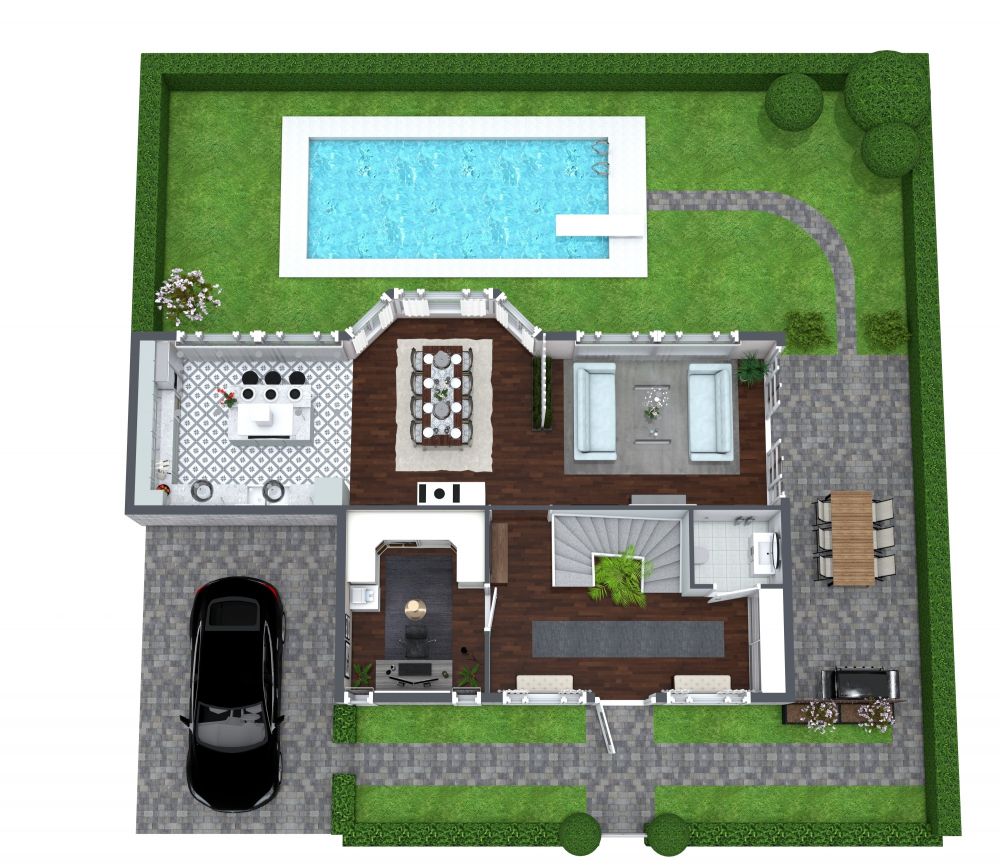Landscape Plan Examples
A Landscape Plan details a property's proposed plant materials, paving, walls, railings, light fixtures, site grading, and other landscape features, whether it be a home, community park, or outdoor space around a commercial building. Here’s a round-up of the typical elements in a landscape design. As you review landscape layout ideas, consider which are the most important to you.
Read More
Grass and lawns - Grasses can include varieties to walk and play on and ornamental grasses that provide height and texture. It’s important to note that most grass lawns require mowing and plenty of water, so they aren’t ideal in dry climates or if your goal is a low-maintenance yard.
Plants and flowers - Plants and flowers include shrubs, succulents, vegetables and herbs, and flower beds. These elements add visual interest to a landscape through various heights, textures, and colors and provide a habitat for wildlife. Plus, if you add vegetables and herbs, you can benefit from fresh-picked produce right from your garden.
Trees - Adding trees to your landscape provides many benefits. They provide shade and, if planted near a house, can lower air conditioning costs. Fruit trees offer lovely sweet treats for your family (and possibly your neighbors when you have a bumper crop!) Trees can provide privacy and also support wildlife. Some things to consider are how close to your home to place a tree (watch out for trees with large roots) and whether you want Evergreen trees (that keep their leaves all year) vs. Deciduous (that lose their leaves each year) or a combination
Walkways and paths - Walkways provide beauty, structure, and function, allowing you to access portions of the property without trampling plants. Common materials include poured concrete or concrete pavers, brick, gravel, flagstone, wood, and stepping stones.
Walls and fences - It’s typical in many areas for property owners to install a fence or wall around the property line. You may want retaining walls for portions of your landscape if you have a sloped property. Low walls, such as a curved wall/bench near a fire pit, can be designed as seating. You can use fences to mark a garden area (such as a border around a vegetable garden or chicken coop). Typical wall and fence materials include wood, wire, or masonry walls made from stucco, brick, concrete, stone, or block.
Patios, decks, and porches - With the latest outdoor living and entertaining trends, decks, porches, and patios are quite popular. But what are the differences?
- Patios are usually flush, or even with, the surrounding ground. Poured concrete and stone are common patio materials. Patios generally require minimal upkeep; in most areas, no permit is necessary to build one.
- Decks are generally raised, often made of natural or synthetic wood, and may require a building permit since they are considered structures. They work well when you want a higher platform to make the most of a view or have uneven land at the planned location for the deck platform.
- Porches are a covered platform that is attached to a structure. You’ll often see a porch at the entrance and exit to a house.
Shade structures - Along with trees for shade, a landscape plan may include manufactured shade structures. Here’s an overview of some of the most popular options:
- A patio cover is a shade structure attached to a house or building.
- A pergola is a freestanding structure with an open or partial roof, but pergola and patio cover are interchangeable in some areas.
- A freestanding structure with a whole roof is often called a pavilion or ramada.
- A gazebo is an octagonal-shaped free-standing structure, also usually with a complete roof.
- An arbor is a smaller structure designed for plants to grow over. Generally placed over a path, arbors define an entrance into another garden area.
Outdoor seating and dining - If you plan an outdoor entertaining or dining area, it’s a good idea to sketch it out as part of the landscape plan. For example, if you plan to purchase standalone furniture, you’ll want to ensure your patio area is the correct size for the set you’ve picked. Or you may desire permanent structures such as built-in benches or outdoor kitchens that are part of the landscape plan.
Hardscape - Hardscape is elements in the landscape plan that are solid and unchanging. Along with the hardscape items mentioned above, this could also include water features, fire pits or built-in heaters, gravel and stones, driveways, swimming pools, and sports courts such as tennis or basketball.
Outdoor buildings - To maximize living and working space, homeowners may add sheds, cottages, accessory dwelling units (ADUs), barns, or pool houses.
Along with creating your dream feature list, collect pictures and layouts showing your vision. If you aren’t a landscape expert, sharing your ideas with a professional is a good idea. A landscape designer will understand the factors that affect a garden, such as soil quality, climate, drainage, maintenance, and permit requirements, to name a few. They can help transform a landscape plan into a detailed site plan and may be able to recommend contractors and nurseries where you can source plants. Soon you’ll be well on your way to creating a beautiful landscaped area.